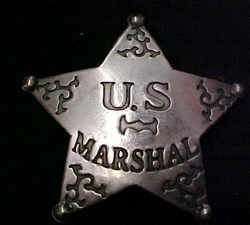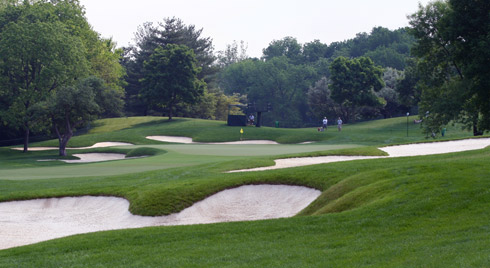 We were waiting on a group ahead of us last weekend and I apologized to the group behind us that we weren’t making more progress. They said it was OK, they didn’t have to be anywhere.
We were waiting on a group ahead of us last weekend and I apologized to the group behind us that we weren’t making more progress. They said it was OK, they didn’t have to be anywhere.
American golfers spend far too long waiting around to hit shots these days. While there are a few die-hards who don’t have to be anywhere soon, slow play is an inconvenience for just about everyone.
What are we going to do about it? I believe that if we as individuals start to do what we can we’ll find that others pick up what we’re doing. Don’t be afraid to gently (or not so gently if necessary) teach your foursome how to play an efficient round of golf. So, what will make a difference?
Number Five: Meaningful Enforcement
 Rarely does one hear, “Speed up or ship out,” from a course ranger these days. As Erik J. Barzeski pointed out in the latest Thrash Talk, Slow Play, modern rangers are largely powerless. That tee time intervals have shrunk to a money-raking rate hasn’t made a ranger’s job any easier.
Rarely does one hear, “Speed up or ship out,” from a course ranger these days. As Erik J. Barzeski pointed out in the latest Thrash Talk, Slow Play, modern rangers are largely powerless. That tee time intervals have shrunk to a money-raking rate hasn’t made a ranger’s job any easier.
Last weekend my group and I were poking along behind a group of young and slow golfers when I said, “We’d be delighted to play through,” to the ranger. He smiled and drove off toward the group ahead. When we reached the next tee the group was already off. He had told the youngest two inexperienced golfers to walk the next hole. It worked perfectly. We could hardly keep up.
If incidents like that were the exception instead of the rule golf would be much easier here in the States. We don’t need more rules, we just need meaningful enforcement. Courses and rangers should take a proactive stance toward speed of play and enforce well known rules.
Number Four: Know Thy Game
 One of my good friends related a good story. A partner asked him what the yardage was into a par five green. My friend looked down and said, “This sprinkler-head says, ‘You’re dreaming.'” Good advice…
One of my good friends related a good story. A partner asked him what the yardage was into a par five green. My friend looked down and said, “This sprinkler-head says, ‘You’re dreaming.'” Good advice…
How many times have you or someone you’ve watched waited for the green to clear thinking they were going to reach the green with their second shot? The only thing they didn’t realize is that the longest they could hit it is 215 yards off the deck and the green was 300 yards away.
Make sure you know your game. If you can’t hit your five-iron 190 yards, hit a four-iron. Be realistic about your chances and don’t gamble unnecessarily. As a result you’ll play faster (and lose less balls and take less strokes).
Number Three: Just Hit the Ball
 Wiggle. Waggle. Check the breeze. Practice swing. Grip. Wiggle. Re-grip. Waggle. Arrrggh! Stop re-gripping Sergio! Hit the ball! I would drive my buddies crazy when I first took up the game. They’d roll their eyes and wait impatiently for me to hit the ball.
Wiggle. Waggle. Check the breeze. Practice swing. Grip. Wiggle. Re-grip. Waggle. Arrrggh! Stop re-gripping Sergio! Hit the ball! I would drive my buddies crazy when I first took up the game. They’d roll their eyes and wait impatiently for me to hit the ball.
Sometimes you take so long because you’re too afraid of hitting a bad shot. Too many wiggles is the result of indecision and ultimately fear. Have a positive outlook on every shot. Instill confidence in yourself and play like it. I play better (without exception) when I choose a club, pick a line, and go. Better players don’t have room for fussing over the ball.
This will require some self-discipline and training on your part but developing a faster pre-shot routine is going to help you and I in the long run. I have worked hard at developing a simple but repeatable pre-shot routine and it is paying dividends in my mental outlook.
When you man up and hit the ball the time it takes to play a round is significantly decreased.
Number Two: Think Ahead
Don’t wait until you’re standing over the ball to begin your thinking process. Watch where your ball lands and begin to calculate your next yardage. Look at your lie and position on the course or green as you get to your ball. Observe yardage markers on the way to your next shot and you’ll have a much better idea of what the shot will entail.

While we all need a little mental break between shots it is easy to be subconsciously assessing the situation as you relax.
Look at your scorecard on the way to the next hole. It will tell you what the par and yardage are. You can begin the process of selecting a club. It is also useful to examine a scorecard or yardage book prior to arriving at a course. This is particularly true if you’ve never played it. Plan ahead a little and you’ll have an advantage.
Number One: Go to School
 It surprises me, as I look back at my own learning curve, how little people understand golf. It is the responsibility of golf course employees, rangers, and playing partners to educate new golfers on etiquette and speed of play.
It surprises me, as I look back at my own learning curve, how little people understand golf. It is the responsibility of golf course employees, rangers, and playing partners to educate new golfers on etiquette and speed of play.
While educating yourself is the best way to learn, we must realize that the golfing public needs to be educated. If someone doesn’t tell golfers what they should and shouldn’t be doing on the course we can’t expect them to know.
There should be a sign next to the cash register telling players how to speed up their round and pro shops could hand out a simple card with receipts that explains how to play efficiently. Reviewing the card with the customer wouldn’t have to take more than 30 seconds.
There are clearly things we all can do to prevent five-hour rounds. Join us in making a difference!
Photo Credit: © Old West Replicas, Andy Lyons/Getty Images, © Erik J. Barzeski,The Sand Trap, Bookstore.

Good article Jeff!
If I was to add another one is to eliminate the cart and enforce walking. Not only is it good for the game but is good for our growing society.
Great points here and elsewhere.
David Baker’s comment about walking is right on.
Some folks (my dad), can’t walk 18. Those who can, should. And shame on designers who build courses with tees 100 yards from the previous green.
The points about using the time when your partner, opponent or fellow competitor is playing his ball to determine what you’re going to do are excellent.
One note – I don’t think that waiting for a group to clear the green on a par 5 is as big of an issue as its been made out to be. I’ve been putting on a green when some guy rolls the ball onto the dance floor, and it is a distraction. When he comes up and says – “Sorry, I didn’t think I could hit it 250 on the roll with a 3 wood,” I would rather he have waited until we had cleared the green.
Yesterday morning we played 18 (walking) in 3 hours 20 minutes. Not the fastest time, but we never rushed a shot, never once hurried, but were always ready to play. Much more fun.
We all hate getting up before the sun rises but if you can get out on one of the early tee off times most of the wanna bee golfers and hackers are still in bed. When my Dad taught me the game we were up at 5:00 am teed of a day dreak and were back home in time for Mom to have breakfast ready.
Plus the dew helps the greens stick. Doesn’t help the putting though.
We have to fix this huge problem. Golf is a sport, but too many golfers think it is something else. Courses encouraging heavy drinking and failing to do their jobs are a major source of the problem. Golfers should have to demonstrate they understand the etiquette before being allowed to play. I propose players having to pass a test of knowledge of the game and its etiquette. I know that sounds draconian, but we have to get times well under four hours. A simple guide could be distributed just as driver license bureaus give out to would be drivers. It is not too much to ask for people to know what they are doing when they play. Having said that, the worst offenders are males who have been playing forever. These guys are never ready, are plum bobbing for a nine on every green and would not let anyone play through for fear to do so would threaten their masculinity. It is time to fix this problem!
How about this novel idea……play from the appropriate tee box. There is nothing more frustrating than playing behind a group of “real men” who play from the tips when they should most definitely be playing forward. Even if somebody in the group is playing (and capable of doing so) from the tips, there is no shame in moving yourself up to the forward tees. Not only will it speed play but it will make the day enjoyable. Whoever the idiot was that decided to call forward tee boxes “women’s tees” killed efficiency.
Also, let people through. Seriously. I usually keep a 3 hour round pace on foot. Even so, if a group gets into a proper position to play through I will not hesitate to allow it. No shame in that.
One more thing. Know how to play through. Don’t put the hammer down and climb right up the backside of the group in front of you. Making loud comments and hitting drives over somebody’s head will more than likely NOT get you through any faster. My favorite is standing on the tee box with your arm extended while performing the “deep lean”. The more lean, the more impatient you are. Makes you look like a jerk. If the group in front doesn’t get the hint, call in the Marshall.
I do believe that carts are the biggest problem with slow play so many courses and golfers think that it speeds the game up but it just slows things down it’s harder to find your ball because you can’t get the same line or perspective on your shots that you do when you walk, you can only cross the fairways at 90 degree angles and you have to keep them at least 30 feet from the green all of those things take a lot more time to do than just walking up to your ball. The other problem is a lot of people don’t take the game seriously they don’t go out and play golf to play golf it’s sort of like a setting for people to go out and talk business and drink. It always seems like most of the time gets wasted on the tee boxes and the greens just decided who is going to drive or put first. I say forget that honor golf let the shorter hitters go first that would really help. If the guy that has the honor drives the ball 275 yards and the group in front of them is 250 yards away it would make sense to have the guy drive that only drives 200 yards otherwise that’s just wasting time if the longer hitter goes first.
The guy who says he’d rather be slowed by 200-yd-max hitters waiting for his green to clear than risk having a rare ball roll onto his green from afar is part of the problem, not the solution.
Tip to quicken play: If your ball is farther down the fairway than is your partner(s), you should not wait behind your partner as he prepares his shot. Keep walking toward your ball out at an angle, toward the rough. Then, when he is about to swing, stop and watch, then finish your walk to your ball. This saves time when you add it all up.